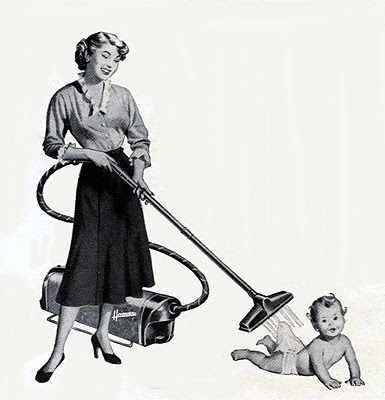
The ancestor to our modern vacuum cleaner was a “carpet sweeper” invented in 1860 by Daniel Hess of West Union, Iowa. The non-motorized machine used a complex system of bellows for suction, and spinning brushes to pick up dirt.
A slight improvement on the original design was patented in 1865 by Ives McGaffey of Chicago. His invention was hand crank-operated, which made it unwieldy to use, as one had to turn the crank and push the machine across the carpet at the same time.
In 1901, Englishman H. Cecil Booth invented a large machine called a suction cleaner. It was powered by an internal combustion engine that ran on gas, and the monstrosity had to be mounted to a horse-drawn cart, and later, an automobile, in order to be transported from place to place. Booth found a receptive clientele among British nobility, which inspired others to improve upon his design.
These early vacuum cleaners did not appeal to the average consumer due to their bulky designs, loud operation, and the odor produced by their exhaust systems. But over the years, enterprising people from around the world fiddled with various suction-cleaning concepts, contributing to gradual improvements.
But then, a breakthrough! In the 1920s, an Ohio janitor named James Murray Spangler created a carpet sweeping contraption out of a soap box, a broom handle, a pillow case, and an electric motor. He then began to sell his machine to local housewives. One of these housewives was a woman named Susan Hoover. (You might recognize the name!) Her husband, William, invested in the mass production of Spangler’s machine and eventually purchased the rights to the design. He named his company Hoover’s Electric Suction Sweeper Company.
The first plastic vacuum cleaner was produced in the 1930s, and the precursor to modern central vac systems was created in 1952 by the Hoover Company, whose name was now synonymous with “vacuuming”.
By the 1960s, vacuum cleaners were much more lightweight and easy to use. The Oreck Corporation produced a uniquely portable model for the hotel industry, and in response to demand from hotel housekeepers, began marketing it to the public.
All of the designs since the first Hoover had used bags to collect the dust and debris suctioned away from carpets. But in the 1970s, James Dyson conceived of a different way of doing things. He thought the vacuum cleaner would benefit from dispensing with the bags altogether. Five thousand one hundred and twenty-seven prototypes later, Dyson unveiled his Dual Cyclone Machine in 1993. Bagless technology was a huge hit with the public. Fast forward to today, and the majority of vacuums sold are the bagless type.
But the bagless vacuum was not the last innovation to disrupt the household cleaning market. In 1996, the first robotic vacuum cleaner was manufactured by Electrolux of Sweden. This serviceable gadget captured the attention of consumers, but ultimately was discontinued because of the ineffectiveness of its early sensors, causing it to collide with other items.
In 2002 the first Roomba was produced by the iRobot company. This robotic vacuum can change directions to avoid colliding with household furniture. Its sensors can detect debris on the floor and keep it from falling down stairs. Only time will tell if robotic vacuums may someday replace manually operated ones, but one thing is for sure: the vacuum cleaner is still evolving!


















